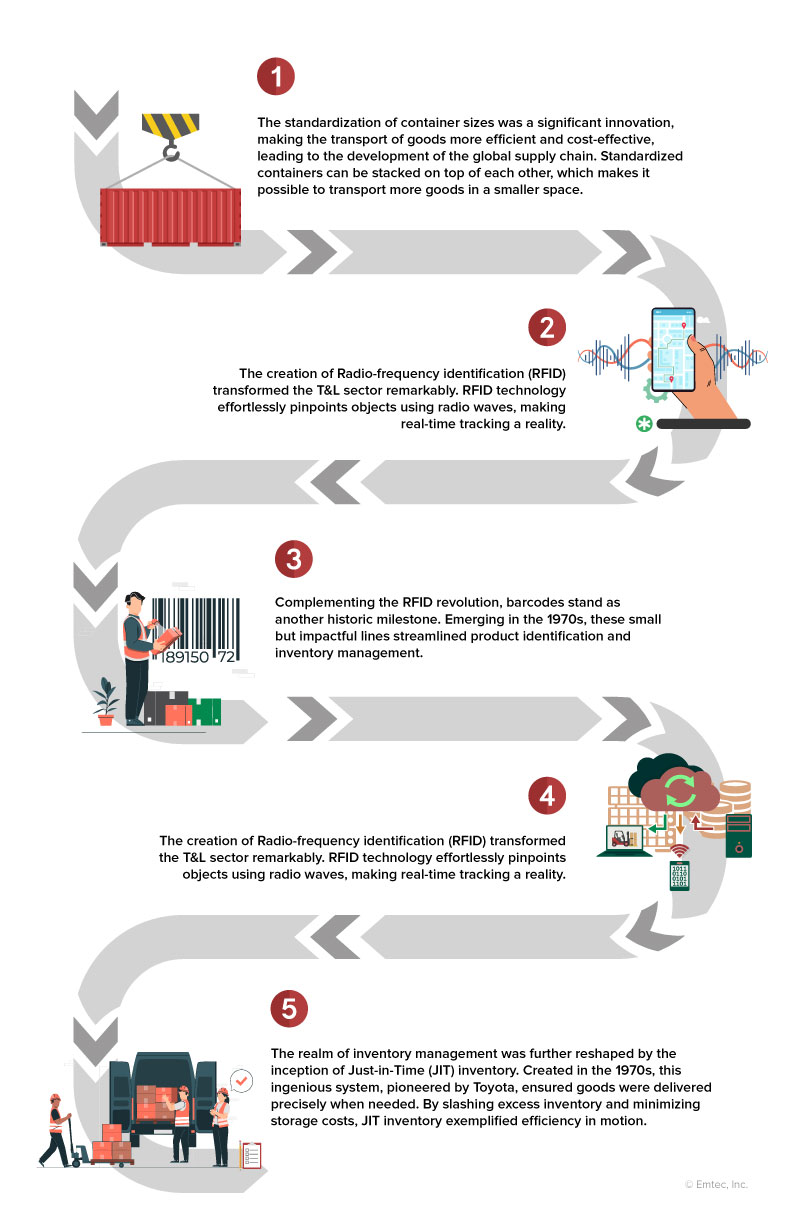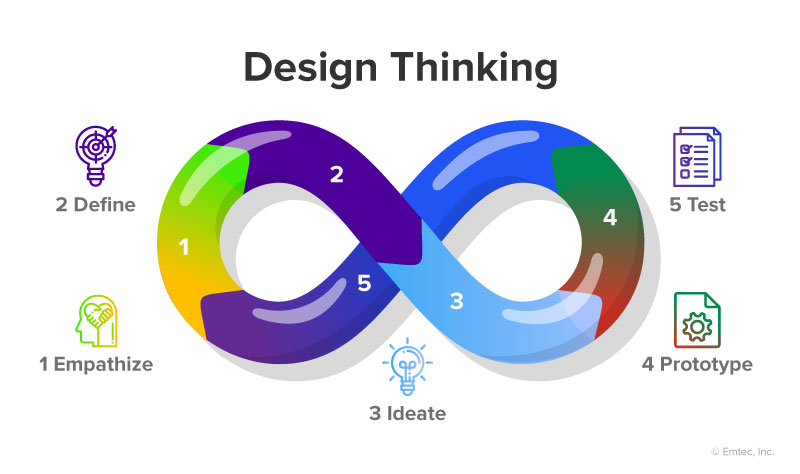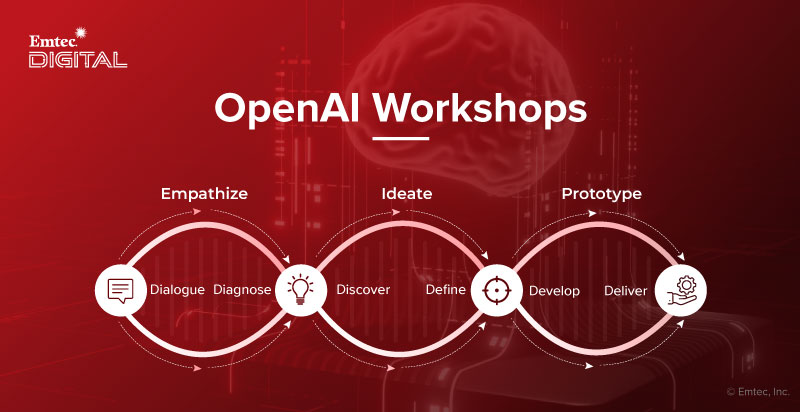10.05.23 By Bridgenext Think Tank

This blog embarks on a thrilling journey where innovation and design thinking intertwine, promising an era of boundless creativity and transformative solutions. Welcome to the revolution in Transportation and Logistics.
In a world that never stops moving, the wheels of transport and logistics have carried us through history propelling us into new realms of transformation and digitization. The emergence of new means of advancement and transportation, driven by technological breakthroughs, opens the door to uncharted possibilities. Globalization has unprecedentedly interconnected markets, necessitating logistics firms to re-evaluate their strategies and operations. Understanding how the logistics industry can innovate isn’t just a theoretical exercise; it’s a practical imperative that can significantly scale operational efficiency.
In the logistics industry, innovations have occurred for decades, driving progress, and continually propelling us into new realms of transformation and digitization. For example:

Collectively, these innovations form the cornerstone of the modern transportation and logistics landscape.
Innovation is more than just creating new products and services. It’s like a jigsaw puzzle where different ideas and concepts combine to create a bigger, transformational picture. Innovative thinking arrives with its own process, it is more than just the first thrill of creating something; it has solid approaches.
DT’s methodology transforms challenges into opportunities, fostering creativity, empathy, and iterative problem-solving. Unlike traditional linear approaches, DT is highly adaptable and encourages continuous learning and improvement. It starts with understanding people’s needs and ends with practical solutions that resonate with them. Let’s delve into the five stages of design thinking and explore how they can guide us through the journey of innovation.

Design thinking is an innovative approach that values empathy as a core principle. It’s all about getting into the mindset of your users before embarking on a journey of innovation. By understanding their pain points, desires, and behaviors, you can gain insights to help create solutions that truly matter. This empathetic approach is essential for a successful innovation process, enabling you to see things from your users’ perspective.
For example, when developing an AI-based conversational bot, we engaged with potential users to understand their needs and challenges. One of the significant problems uncovered was that organizations were using multiple transportation-related systems. Users had to spend a lot of time switching between numerous applications to get data, which was inefficient. They needed a single-window solution to empower them to execute multiple operations from a single application.
Empathy consists of understanding, connecting, and resonating with the emotions and perspectives of others. By embracing empathy, we bridge gaps, nurture understanding, and create a more compassionate technology world.
The next phase involves gathering and analyzing data from the ‘empathize’ stage. This step requires you to reframe the challenge in a way that focuses on human experience. By tapping into the insights gained from empathy, you can dig deeper into the root causes of the problem rather than simply addressing the symptoms. This approach ensures that your innovation efforts align with your users’ needs.
In the previous phase of empathizing, we immersed ourselves in the users’ world to truly understand their needs and challenges. We identified that the challenge extended beyond just using multiple transportation-related systems. The core problem was the inefficiency and frustration caused by fragmented operations. The organization’s valuable time and resources were being wasted, impacting their productivity and overall satisfaction. By reshaping the problem through a human-centric lens, we can tackle the most complex challenges and find innovative solutions to overcome these obstacles.
In the realm of innovation, Ideation is where the magic happens! This journey of ideation showcases how pooling diverse perspectives can lead to a groundbreaking feature, reminding us that in the realm of creativity, possibilities are as limitless as our imagination. This is the stage where you unleash your creativity and generate many ideas. No idea is too crazy, as it can spark ingenious solutions. Collaboration and diverse perspectives play a significant role in generating a pool of potential solutions. This stage challenges assumptions and stretches your imagination.
Our ideation for the AI-based conversational bot took around six months, with many stakeholders included in the process. The resulting consensus was that the tool should work like a human and must communicate in natural language. We then designed the product to incorporate NLP as a significant feature.
Ideation is indeed the spark that ignites brilliance!
Now, it’s time to transform your ideas into tangible prototypes. After the ideation phase, teams start working on prototypes, which can be as simple as sketches or as complex as interactive mock-ups, depending on the context. Building a prototype allows you to visualize your solution and test its viability in the real world. Sharing prototypes with users is crucial, enabling you to gather valuable feedback that guides further iterations. In the dynamic realm of innovation, prototyping breathes life into ideas, transforming them into tangible possibilities. We refine our creations by sharing prototypes with users and gathering their insights, ensuring they resonate with genuine needs.
Testing is the final stage of the design thinking process. By putting your prototype in the hands of users, you gain critical insights into its strengths and weaknesses. This feedback-driven approach allows you to refine and improve your solution iteratively. It’s perfectly normal to return to previous stages as new insights emerge. This iterative loop makes design thinking such a powerful tool for innovation!
As our prototypes were shared with actual users from the T&L industry, a wealth of insights flooded in. With user feedback, the team delved into the iterative refinement process. Strengths were accentuated, and weaknesses were meticulously addressed. This feedback-driven approach became the driving force behind every enhancement. The team viewed this as not just a testing phase but a dynamic cycle of improvement, a testament to the power of design thinking. Abstract ideas were translated into tangible possibilities, and concepts were brought into reality with the potential to transform industries.
Design Thinking (DT) is not just for designers — the great inventors of engineering, science, literature, art, music, and business have used it. DT is guided by several key principles that drive its iterative and human-centered approach to creating digital products and services. Design thinking encourages creativity and experimentation, leading to new and innovative solutions to problems.
Here are some key areas where design thinking has a significant scope in driving innovation:
| Areas | Information |
| Product Development | DT can revolutionize how products are conceptualized, designed, and marketed.
Organizations can create products that meet user needs and preferences by empathizing with users, understanding their pain points, and rapidly prototyping and iterating. |
| Service Design | DT can improve services’ quality and user experience across various sectors, including healthcare, finance, and T&L. It enables organizations to create more efficient, effective, and customer-oriented services. |
| User Experience (UX) Design | Design thinking is crucial in UX, ensuring that digital interfaces and interactions are intuitive, user-friendly, and meaningful. |
| Business Model Innovation | DT can be used to explore new business models or reimagine existing ones. It encourages a deep understanding of customer needs and market dynamics, leading to the development of innovative business models. |
As we continue to chart our course guided by user experiences, we invite fellow innovation enthusiasts to embark on their own inventive odyssey. Our dedication to nurturing innovation has led us to unveil a series of OpenAI Workshops.
With the transformative power of AI, the guiding light of design thinking, and our boundless enthusiasm for innovation, envisioning “Innovation on Steroids” becomes a thrilling possibility.

We welcome you to participate in these enlightening workshops which are tailored to help you further understand the vast potential of AI within your organization. Our team will spend a couple of hours with you to explore the scope of innovation.
Get in touch with our team, and they’ll help you register for our informative AI-powered innovative workshops.